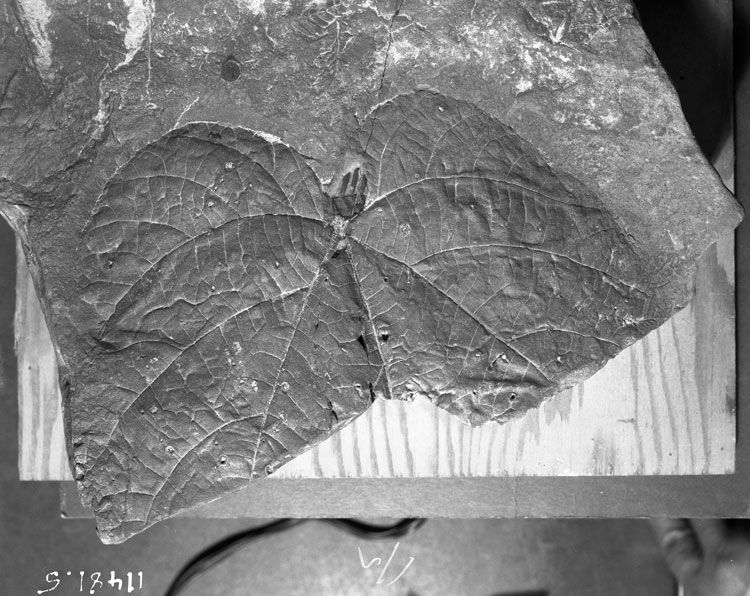Locality
USGS11481
69.382° Long. -148.725°
Sagavanirktok (B-3) Quad.
Sagwon section. Alternating beds up to 1.5 m thick of coal and gray shale containing clay ironstone concretions are exposed in a gully on the west side of the Sagavanirktok River. Plant megafossils were confined to the concretions which weathered to a rusty brown. These beds are probably laterally equivalent to those of localities 11479 and 11480.
Description
Leaf: simple; symmetrical; wide ovate; apex acute with a rounded tip; base lobate, the lobes tending to overlap below the junction of the petiole and lamina; margin crenate, teeth with rounded microscopically retuse apices and angular sinuses, glands in tooth apex often in sinus, tooth size variable but rarely more than 2 mm wide, margin apparently entire very close to the petiole; venation basal, imperfect marginal actinodromous; primary midvein more or less straight, moderate; a-pectinals departing base of midvein at 50° curved, semicraspedodromous, a-abmedials departing at 55-70°, angle increasing near margin, curved, brochidodromous and craspedodromous; b-pectinal veins arising from base at midvein at an angle of 120°, moderate, uniformly curved, curvature may become abrupt at the point of departure of the b-abmedials, b-abmedials arising at an angle of 70-75°, curved, branched, degree of curvature increasing near the margin (particularly in those veins originating close to the petiole) to form loops joining a branch of the superadjacent abmedial at approximately 90°, those abmedials originating from the b-pectinals nearer the margin have less well-devoloped loops partly composed of third order veins, the more basal abmedials branch abmedially to give off third order semicraspedodromous veins at angles of 55-65°; superior secondary veins arising from the primary midvein at angles of approximately 55°, moderate curved, often repeatedly branching abmedially, branches curved, craspedodromous or semicraspedodromous; tertiary veins percurrent, usually convex, sometimes straight, sinuous or even concave near the margins, often forked, arranged concentrically to the junction of the petiole with the lamina, forming various angles with both ad- and abmedial sides of secondaries with a mean of 90°; fourth order veins percurrent, sinuous or more or less straight, often forked, sometimes forming an orthogonal reticulum; fifth order veins predominantly orthogonal, areolation imperfect, randomly arranged, predominantly quadrangular of medium size and often surrounding once branched veinlets.
Remarks
These well-preserved leaves with pronounced venation compare well with the palmate dilleniids based on the typical characters outlined in Hickey and Wolfe (1975). They possess actinodromous venation with semicraspedodromous secondaries and tertiary veins arranged concentrically around the petiole junction with the lamina. The architecture is not always consistent between the various parts of the lamina. For instance the pectinal abmedials may be looped, semicraspedodromous or craspedodomous and glands in the sinuses of the teeth are not always present.
The teeth have glandular apices and are apparently similar to those figured as 'Salicoid' in Hickey and Wolfe (1975) and in particular the example of Idesia polycarpa Maxim (Hickey and Wolfe, 1975, Fig. 16). The characteristic bracing lateral veins of Chloranthoid teeth are lacking in specimen USGS 11488.1 although some teeth do have pronounced looping of subsidiary veins in them. Such looping is also seen in Salicoid and to some extent Violoid teeth.
